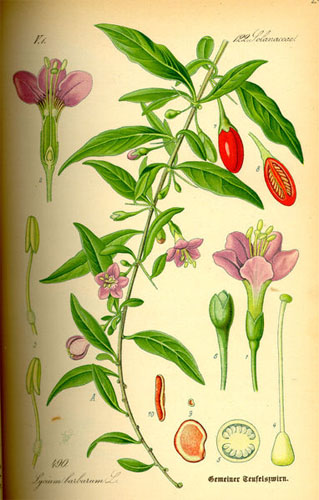 From Otto Wilhelm Thomé: Flora von Deutschland, Österreich und der Schweiz (1885) - Permission granted to use under GFDL by Kurt Stueber. Source: www.biolib.de |
 By B. Osborn from Flora of Australia , vol. 29. |
 Line drawing by L. Haegi. |
 By G. Dashorst, Fl.S.Australia 3, f. 566 partly (1986). |

Synonymy
*Lycium barbarum L.,
T: `Habitat in Asia,
[L. chinense auct. non Miller; G.Bentham, Fl. Austral. 4: 467 (1869)]
Description
Shrub to 2.5 m with weak, arching branches; lateral branches often few, reduced to short, leafless spines.
Leaves ovate to elliptic, scarcely fleshy when fresh, green; clustered leaves to 25 mm long, single alternate leaves to 55 mm long.
Pedicels 6–15 mm long. Calyx campanulate to broadly ellipsoid, 3–4 mm long, sometimes 2–lipped. Corolla 10–12 mm long, pale mauve towards limb, the lobes deep mauve above; limb strongly reflexed. Stamens 5, exserted for 3–8 mm. Pistil 8–11.5 mm long.
Fruiting calyx split deeply once or twice. Berry ellipsoid, 3–4 mm diam., red, with c. 20 seeds. Seeds 2 mm long, 1 mm wide, yellowish.
Distribution and ecology
Native to central China; introduced to Australia as a garden plant, possibly from Europe, and established in a few areas in coastal and near-coastal south-eastern Qld, N.S.W., Vic., eastern Tas. and south-eastern S.A.
Common name
Chinese Boxthorn, Goji berry, Wolfberry, Matrimony Vine,Duke of Argyll's Tea Tree (see www.nationmaster.com/encyclopedia/Duke-of-Argyll's-Tea-Tree)
Selected specimens
S.A.: Near Aldinga, D.E. Symon 10567 (AD, ADW). Qld: Brisbane, C.T. White 10227 (BRI). N.S.W.: Leumeah, E. McBarron 122001 (NSW). Vic.: Sale, 5 Mar. 1978, E. Lyndon (MEL).
Derivation of epithet
From barbarum, Latin for foreign.
Images and information on web
An illustration of L. barbarum from Otto Wilhelm Thomé's - Flora von Deutschland Österreich und der Schweiz (1885 - 1905) can be found on the web at http://caliban.mpiz-koeln.mpg.de/~stueber/thome/band4/tafel_029_small.jpg or at www.cancerdecisions.com/images/tafel.jpg
A photograph of the flower and leaves of this species can be seen at www.flogaus-faust.de/e/lycibarb.htm and also at www.floracyberia.net/spermatophyta/angiospermae/dicotyledoneae/solanaceae/lycium_barbarum.html
L. barbarum is thought to be the source of Himalayan Goji juice, a dietary supplement presently in great favour. For a discussion which considers some of these claims see http://chetday.com/gojijuice.htm or for further information about its use in Asia see www.nationmaster.com/encyclopedia/Duke-of-Argyll's-Tea-Tree
Further information about L. barbarum can be found at the project Lycieae site which brings together species lists, keys, publications and world-wide information and images of Lycium species.
For information about the toxicology of Lycium species search in the FDA Poisonous Plant Database
A fact sheet for this species can be downloaded from the SA eFlora site.